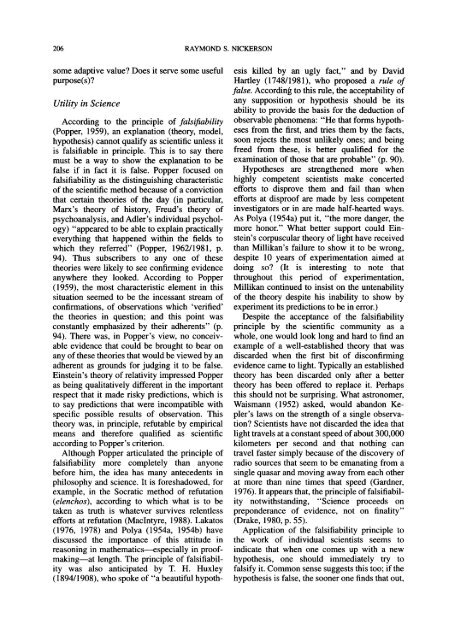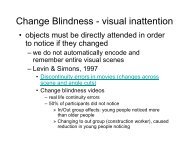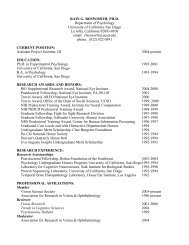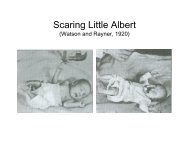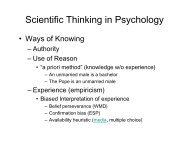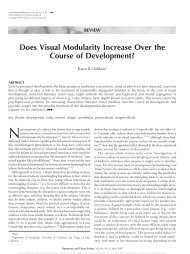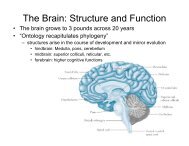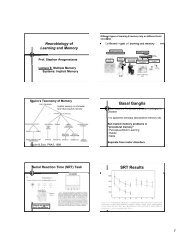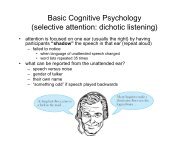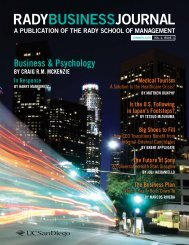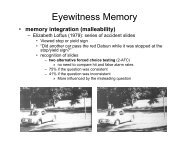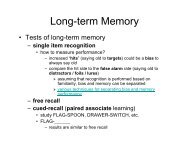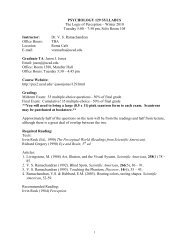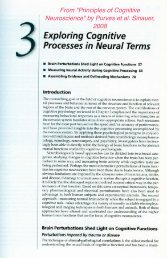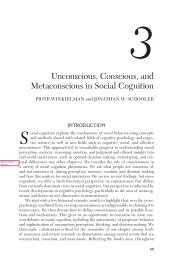Confirmation Bias: A Ubiquitous Phenomenon in Many Guises
Confirmation Bias: A Ubiquitous Phenomenon in Many Guises
Confirmation Bias: A Ubiquitous Phenomenon in Many Guises
Create successful ePaper yourself
Turn your PDF publications into a flip-book with our unique Google optimized e-Paper software.
206 RAYMOND S. NICKERSON<br />
some adaptive value? Does it serve some useful<br />
purpose(s)?<br />
Utility <strong>in</strong> Science<br />
Accord<strong>in</strong>g to the pr<strong>in</strong>ciple of falsifiability<br />
(Popper, 1959), an explanation (theory, model,<br />
hypothesis) cannot qualify as scientific unless it<br />
is falsifiable <strong>in</strong> pr<strong>in</strong>ciple. This is to say there<br />
must be a way to show the explanation to be<br />
false if <strong>in</strong> fact it is false. Popper focused on<br />
falsifiability as the dist<strong>in</strong>guish<strong>in</strong>g characteristic<br />
of the scientific method because of a conviction<br />
that certa<strong>in</strong> theories of the day (<strong>in</strong> particular,<br />
Marx's theory of history, Freud's theory of<br />
psychoanalysis, and Adler's <strong>in</strong>dividual psychology)<br />
"appeared to be able to expla<strong>in</strong> practically<br />
everyth<strong>in</strong>g that happened with<strong>in</strong> the fields to<br />
which they referred" (Popper, 1962/1981, p.<br />
94). Thus subscribers to any one of these<br />
theories were likely to see confirm<strong>in</strong>g evidence<br />
anywhere they looked. Accord<strong>in</strong>g to Popper<br />
(1959), the most characteristic element <strong>in</strong> this<br />
situation seemed to be the <strong>in</strong>cessant stream of<br />
confirmations, of observations which 'verified'<br />
the theories <strong>in</strong> question; and this po<strong>in</strong>t was<br />
constantly emphasized by their adherents" (p.<br />
94). There was, <strong>in</strong> Popper's view, no conceivable<br />
evidence that could be brought to bear on<br />
any of these theories that would be viewed by an<br />
adherent as grounds for judg<strong>in</strong>g it to be false.<br />
E<strong>in</strong>ste<strong>in</strong>'s theory of relativity impressed Popper<br />
as be<strong>in</strong>g qualitatively different <strong>in</strong> the important<br />
respect that it made risky predictions, which is<br />
to say predictions that were <strong>in</strong>compatible with<br />
specific possible results of observation. This<br />
theory was, <strong>in</strong> pr<strong>in</strong>ciple, refutable by empirical<br />
means and therefore qualified as scientific<br />
accord<strong>in</strong>g to Popper's criterion.<br />
Although Popper articulated the pr<strong>in</strong>ciple of<br />
falsifiability more completely than anyone<br />
before him, the idea has many antecedents <strong>in</strong><br />
philosophy and science. It is foreshadowed, for<br />
example, <strong>in</strong> the Socratic method of refutation<br />
(elenchos), accord<strong>in</strong>g to which what is to be<br />
taken as truth is whatever survives relentless<br />
efforts at refutation (Maclntyre, 1988). Lakatos<br />
(1976, 1978) and Polya (1954a, 1954b) have<br />
discussed the importance of this attitude <strong>in</strong><br />
reason<strong>in</strong>g <strong>in</strong> mathematics—especially <strong>in</strong> proofmak<strong>in</strong>g—at<br />
length. The pr<strong>in</strong>ciple of falsifiability<br />
was also anticipated by T. H. Huxley<br />
(1894/1908), who spoke of "a beautiful hypoth-<br />
esis killed by an ugly fact," and by David<br />
Hartley (1748/1981), who proposed a rule of<br />
false. Accord<strong>in</strong>g to this rule, the acceptability of<br />
any supposition or hypothesis should be its<br />
ability to provide the basis for the deduction of<br />
observable phenomena: "He that forms hypotheses<br />
from the first, and tries them by the facts,<br />
soon rejects the most unlikely ones; and be<strong>in</strong>g<br />
freed from these, is better qualified for the<br />
exam<strong>in</strong>ation of those that are probable" (p. 90).<br />
Hypotheses are strengthened more when<br />
highly competent scientists make concerted<br />
efforts to disprove them and fail than when<br />
efforts at disproof are made by less competent<br />
<strong>in</strong>vestigators or <strong>in</strong> are made half-hearted ways.<br />
As Polya (1954a) put it, "the more danger, the<br />
more honor." What better support could E<strong>in</strong>ste<strong>in</strong>'s<br />
corpuscular theory of light have received<br />
than Millikan's failure to show it to be wrong,<br />
despite 10 years of experimentation aimed at<br />
do<strong>in</strong>g so? (It is <strong>in</strong>terest<strong>in</strong>g to note that<br />
throughout this period of experimentation,<br />
Millikan cont<strong>in</strong>ued to <strong>in</strong>sist on the untenability<br />
of the theory despite his <strong>in</strong>ability to show by<br />
experiment its predictions to be <strong>in</strong> error.)<br />
Despite the acceptance of the falsifiability<br />
pr<strong>in</strong>ciple by the scientific community as a<br />
whole, one would look long and hard to f<strong>in</strong>d an<br />
example of a well-established theory that was<br />
discarded when the first bit of disconfirm<strong>in</strong>g<br />
evidence came to light. Typically an established<br />
theory has been discarded only after a better<br />
theory has been offered to replace it. Perhaps<br />
this should not be surpris<strong>in</strong>g. What astronomer,<br />
Waismann (1952) asked, would abandon Kepler's<br />
laws on the strength of a s<strong>in</strong>gle observation?<br />
Scientists have not discarded the idea that<br />
light travels at a constant speed of about 300,000<br />
kilometers per second and that noth<strong>in</strong>g can<br />
travel faster simply because of the discovery of<br />
radio sources that seem to be emanat<strong>in</strong>g from a<br />
s<strong>in</strong>gle quasar and mov<strong>in</strong>g away from each other<br />
at more than n<strong>in</strong>e times that speed (Gardner,<br />
1976). It appears that, the pr<strong>in</strong>ciple of falsifiability<br />
notwithstand<strong>in</strong>g, "Science proceeds on<br />
preponderance of evidence, not on f<strong>in</strong>ality"<br />
(Drake, 1980, p. 55).<br />
Application of the falsifiability pr<strong>in</strong>ciple to<br />
the work of <strong>in</strong>dividual scientists seems to<br />
<strong>in</strong>dicate that when one comes up with a new<br />
hypothesis, one should immediately try to<br />
falsify it. Common sense suggests this too; if the<br />
hypothesis is false, the sooner one f<strong>in</strong>ds that out,


